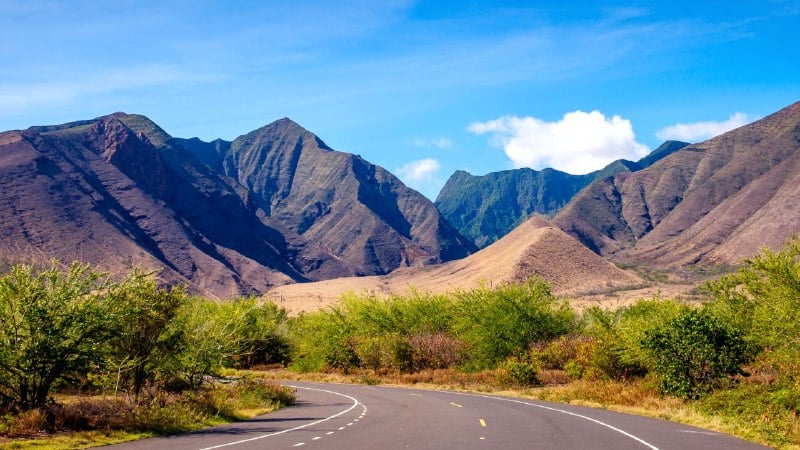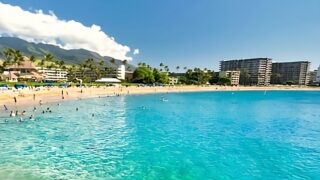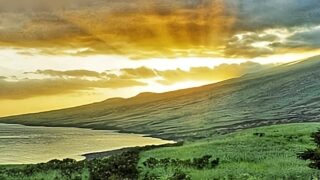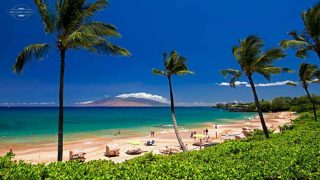Even Kapalua’s once-green golf courses are now brown for the first time that we can remember. Maui is moving to ban new luxury pools through 2030 as drought conditions worsen across the island. What was once one of Hawaii’s greenest corners is facing the limits of its water supply, forcing county leaders and developers to make choices that will reshape West Maui’s future for visitors and residents alike.
What’s changing.
The Maui Planning Commission has voted to support a ban on new private swimming pools in West Maui through 2030. The measure now heads to the County Council, which is expected to take up the issue as a high priority. County officials said there were approximately 70 pending applications for new pool permits related to vacation rentals and home construction. Those applications are effectively on hold until the moratorium is approved or rejected.
The ban applies only to new private pools, not existing ones, and allows exemptions for homes being rebuilt after the Lahaina fire. It will stay in place until December 31, 2030, or until a groundwater availability study is complete, whichever comes first. According to county data, an average household in Lahaina uses about 500 gallons of water daily, while maintaining a typical pool uses roughly 56 gallons a day for topping off and cleaning.
Existing resort and condominium pools are currently unaffected, but the symbolism is unmistakable. Water use tied to luxury amenities has become a target of public frustration in a part of Maui that is still trying to recover from the fires and now faces a second crisis: drought.
The PGA departure.
In September 2025, the PGA Tour announced that The Sentry will not be held at Kapalua in 2026, citing drought conditions, water conservation requirements, and logistical challenges. It marks the first time in decades that Maui will not host the season-opening tournament.
This fall, those same fairways are visibly brown in places. The shift in landscape has become an unmistakable sign of how drought is changing both Maui’s appearance and its tourism reputation.
The numbers: pools versus households.
The argument for the pool ban comes down to simple math. West Maui remains in a Stage 2 water shortage, which calls for voluntary conservation but allows stricter limits when needed. County officials say that while a single pool’s daily water use may seem small, the combined demand from all pending projects adds up fast.
Residents frame the issue as one of fairness. Affordable housing developments have been waiting years for approval or funding, while luxury homes and vacation rentals with pools and extensive landscaping continue to move forward. Many who spoke at recent hearings said it is time to prioritize essential needs over amenities and direct scarce water resources toward families and fire recovery, rather than new private luxury pools.
The Kaanapali test case.
The county’s Urban Design Review Board is considering a five-home subdivision in Kaanapali, each designed with its own pool and landscaped grounds. For many on Maui, that project captures the growing disconnect between water conservation appeals and the reality of luxury construction still moving ahead. For builders, it raises questions about how much room remains for high-end design if the drought continues.
Developers warn that delays or redesigns could ripple through Maui’s construction economy, while county officials say slowing growth now is the only way to maintain long-term water stability.
What visitors will notice.
While the proposed ban applies only to private pools, it reflects a broader strain on Maui’s water supply that visitors are beginning to see all around them.
Visitors to West Maui will not find empty hotel pools or closed water slides. Those continue as usual. What stands out instead is how dry everything looks and feels. The hills from Lahaina to Kapalua have turned brown, irrigation has been cut back, and even resort landscaping is beginning to fade.
Even Kauai, usually lush and wet, is now unusually dry, more so than we can ever recall. But nowhere is it more visible than on Maui, where the contrast between blue pools and brown slopes has become striking. Some construction sites have gone quiet while the county sorts out what comes next. For travelers arriving in the months ahead, that look of drought will be impossible to miss.
The bigger picture.
West Maui officials say they have never seen conditions this dry. The proposed pool ban highlights the limitations of Maui’s water system and how drought is starting to shape what can be built and when. If conditions worsen, restrictions could expand to landscaping and other nonessential water uses.
What happens next.
The County Council vote is expected later this month. The groundwater study results will determine whether restrictions ease before 2030. Once passed, the enforcement and exemption rules will be outlined by the Department of Water Supply.
For now, Maui’s message to visitors and developers is simple. The island’s water supply is finite, and residential recovery takes priority. The pool ban does not affect existing resorts or homeowners, but it marks a shift in how West Maui defines both luxury and sustainability. Travelers arriving later in 2025 will see it firsthand in the brown slopes above Kapalua and the slower pace of new development across the coast.
If push comes to shove, should Maui focus its limited water on rebuilding communities or sustaining visitor amenities? Tell us what you think in the comments.
Get Breaking Hawaii Travel News







Maybe it’s time to use some of Hawaii’s surplus tax dollars on desalination plants for ocean water. Maui has been in a drought trend for over 10 years.
I always thought west Maui mountains was one of the rainiest in the USA. Is it a mismanagement issue or just no water.
They have know for years about the water issues on the West side of Maui.
Desalination plants could have been built years ago with the amount of state taxes collected.
But in Maui they can’t even build a walking overpass bridge for kids in Kihei. They spent 16 million on a round about that was never going to work.
Now its been 2 years since they said they would build a overpass for the kids to cross the highway.
It will cost 20 million.
So lets see, 36 million will be spent instead.
And they want to talk about swimming pools being filled cost to much?
Sorry but the government of Maui
is beyond incompetent. You choose the word. Now they lost a 50 million dollar golf tournament
and blame on lack of water.
Never proactive here.
Insane incompetence making more problems. Welcome to Maui run by people with zero ability to prioritize anything for the community or tourist. Not sure how much longer I will be a resident here with this type of pathetic leadership.
Hawaii’s politicians are less than useless.
They speak of West Maui as if it were a desert when the West Maui Mountains typically receive over 300 inches (25 feet) of rain annually.
If any of them had Any common sense, they would have been planning upgraded water delivery systems decades ago.
In 1901 engineers confirmed the economic viability of carrying water from the Big Island’s mountains to the cane fields 20 miles away and by 1905 the Kohala Ditch was completed, and it still functions as a fluming attraction today.
Hawaii’s politicians are not only short-sighted, they are asleep at the switch.
Do not ban pools
They can save someone or a structure from fire
Require
Pool cover that prevents evaporation
Probably a lot of bad plumbing and water leaks unnoticed. 509 gallons per day is like 10 50gallon barrels or showers that run for 5 hours straight with a 1.5gpm shower head per day. I don’t think me and my wife use over 1200 gallons of water in a whole month. Really amazing is how many swim trunks or shorts can fit in a load of laundry? Probably a few more than one pair.
So with a water issue, the County see’s fit to continue to issue permits for resorts to be built and new large housing projects. Where is this water supposed to come from to supply these new projects? I don’t mind seeing the replacement homes being built in Lahaina, ones that were destroyed but all these mega mansions and other housing developments will require more water. Where is it going to come from or do we continue to restrict everyone to the point of limiting showers, etc?
Take care of your local residents and restore those homes burned in the Lahaina fire.
Unhappy hotel and restaurant workers translate into poor service for vacationing visitors, personally I won’t be choosing Maui as my destination based on the recent articles on Beat of Hawaii.
Build some desalination pkants, there is over 400 in the US and many more around the world and huge ones too. We have a perfect location for it and the environmental impacts can be managed.
An average household use of 509 gallons of water daily is an extreme exaggeration. No household of 5 would use that amount unless you are filling a pool daily, washing cars daily. Watering grass 24-7
Rebuild the Community. As a visitor, I know that Maui would be nothing without the Aloha of the residents.
Of course Maui residents have to take priority. No reasonable person could argue otherwise until it is determined how much water is really available. As to the Sentry PGA Tour event leaving my understanding is that it is a one year thing until the course can use the water needed to return it to Tour level conditions. A very respectful approach toward local residents in my opinion.
Someone needs to run a sanity check on your water usage numbers.
500 gallons a day for a household is ridiculous – I just took a look at our water bill for two people in a house with two baths, a washer, and dishwasher (I do not water the lawns) and it is for 4,000 gallons – for the entire month of September. And that is about twice our normal usage (I’ll have to keep an eye on that).
Unless Lahainans are the most water-wasting people in existence, something is screwing up those numbers. 15,000 gallons seems absurd unless you average a 10 person household each taking two showers a day.
Of course residents must come first. The ban is a reasonable approach until it can be determined how much water really is available. As to the Sentry my understanding is they have every intention of returning when they know the course can be maintained properly without hurting Maui residents. I good neighbor approach in my view.